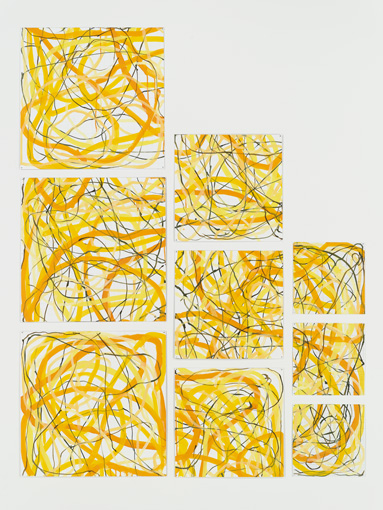Bigger Is Better: Jennifer Bartlett

DETAILS OF RECITATIVE, 2009–2010. COURTESY THE ARTIST AND PACE GALLERY
Color undulates across three walls like an oversize bar-graph meter in the American artist Jennifer Bartlett’s latest large-scale installation, Recitative. Her largest work to date at 158 feet, Recitative is five feet longer than Bartlett’s first major installation, Rhapsody (1976), which earned her initial international recognition. Describing the titles of these two works, Bartlett explains, “Rhapsody was bombastic, while Recitative denotes that dry part in opera—it sounds like spoken word and is often much more frank than the sung parts.”
Although perhaps not bombastic, Recitative is striking in its enormity: grouped in multiples of three, a total of 372 square steel plates (Bartlett’s favored medium for her large-scale pieces) run in an abstract panorama around the room. Where Rhapsody compiled the plates of the same size, Recitative is methodically arranged in three different sizes. Each plate consists of non-representational markings of dots, dashes and lines, using enamel on silkscreen over the steel. Evolving plate by plate into a whole allows an element of chance to enter the work and, in explaining her process, Bartlett says, “I made this piece in a house the size of a quarter and I did a lot of the sections of the piece on a kitchen table. As I made sections they would be transported to New York, photographed, and then I used the photographic record to follow what I wanted to do. So it was more of an evolution while I was working section by section.”
Although Minimalist in the work’s abstract markings, it also follow various conceptual formulas, through Bartlett’s fascination with geometrics and counting as well as the influence of Sol LeWitt and his “Paragraphs on Conceptual Art.” The grid-like structure loosely follows particular combinations and rules according to the color spectrum, yet Bartlett makes the simplicity of this procedure paramount: “I wanted to do something abstract, focused on color, and as simply as possible, and this piece evolved from that. I chose the colors in the most primitive of all fashion: the primaries, the secondaries, and the tertiaries for this piece.”
Rhythms are generated through the fluctuating color, markings, and plate sizes across the walls. Much like an opera singer adopting the rhythms of ordinary speech and refraining from repeating lines in contrast to formally composed songs, Recitative sustains its momentum through an ever-mutable and evolving, yet carefully organized, melody.
“RECITATIVE” OPENS JANUARY 12. THE PACE GALLERY IS LOCATED AT 545 WEST 22ND STREET, NEW YORK.






